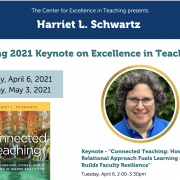Authentic Teaching and Connected Learning in the Age of Covid
“How we are with our students throughout this pandemic will teach them at least as much as the content of our courses.” This is an updated version of a message I shared via social media soon after my university moved to remote teaching in response to COVID-19. The past few weeks of transitioning courses and advising has deepened my sense of responsibility and challenge we, as faculty, face during this time.
We are always teaching on at least two levels. Clearly, we teach the essence of our disciplines, and at the same time, by virtue of our presence and approach, we model ways of being in the world. In this time of uncertainty, anxiety, and fear, we have the potential to model acceptance of imperfection in ourselves and our students and teaching as an act of care (hooks, 1994; Noddings, 2003).
Each of us, as we teach remotely throughout this pandemic, has the opportunity to give our students much more than they expected at the start of the semester. Whether you are a seasoned online teacher or a novice, and whether the courses you are currently teaching were online from the start or abruptly transitioned, we are all positioned to create important moments and spaces for students who, like us, now live in a time of uncertainty and increased stress. I am mindful as I write this that some of our students already lived in chaos and instability and for them the severity of this moment is magnified. We must always remain cognizant of their daily struggles.
The Power of Connection
I believe interactions and relationships are always at the center of teaching, however, in typical times, these aspects of our work can go unnoticed as we rely on the routines and rhythms of higher education.
Now, stripped of routine and rhythm, we find that communication and relationships are more vital than ever.
Along with teaching the content of our courses, we as faculty can be a solid presence in our students’ lives. We can offer continuity amid chaos, solid ground in the midst of disruption, care in a time of fear, and connection despite social distancing (which, as many others have suggested, is better named physical distancing).
The suggestion that we can bring all of this to our students’ lives may seem like a tall order, given that we are also dealing with an intense challenge. Teaching and learning are imperfect human endeavors. By modeling acceptance of ourselves when we falter, we can encourage students to be gentle with themselves. And by expressing care and support when students stumble, we teach compassion.
The Power of This Moment
I teach graduate students, and before the pandemic, most would have worked all day before arriving for class. I have always hoped that my classrooms are a place where students can leave the cares of their lives behind and focus on their growth and development. I’ve occasionally heard students say that they don’t tell their spouses about breaks or when classes are canceled. Instead, they go to campus or a coffee shop and do their schoolwork or use the time simply to take a break. These stories reinforce the idea that students may find refuge in school, slices of time where they can step away from the demands and pressures of life, and do something for themselves. Likewise, at present, if school can be a momentary haven and we serve students well, and there is still the possibility of learning, even with the challenges of living through a pandemic.
Continuity and a Solid Presence
Life now is different for most of us than it was even one month ago. The routines that formed the texture of our days are changed or gone, and we may no longer engage with the people, jobs, and communities that gave our lives stability. Because many of us are teaching classes that were already in motion before the pandemic, we have the opportunity to offer students some sense of continuity. Logging on to do coursework and meeting with each other online re-establishes at least some connection with our lives before COVID-19 and may, for an instant, steady the whitewater in which we find ourselves.
We now have an essential opportunity to be an authentic solid presence in the lives of others, a vital element of collegiality and leadership even in calm times. When we provide this steady presence, we show students how they might do the same for others. As we engage with students remotely, we construct learning spaces (synchronous and asynchronous), and then through each interaction, we create small moments of big possibility. Every communication has the potential to say: “I see you,” “I care,” and “you matter.” And we are connected, even from afar.
Authenticity
What is authenticity in teaching when we might feel as overwhelmed and concerned as our students? I propose that authenticity in teaching, even in the best of times, is about bringing our humanity to work while also retaining role clarity (Schwartz, 2019). For example, I routinely share stories of article revise-and-resubmits and rejections with students, so they will know that even full tenured professors deal with critical feedback and rejection. I don’t share these stories if I am particularly upset. Still, when I can share a story such that students may find it affirming and not sense that I need them to take care of me, I am being authentic and concurrently enacting my role as a teacher in the lives of students.
Many faculty members are overwhelmed and anxious, teaching in a changed and changing context. And some are also managing a house full of energetic children or caring for elders. Many face some combination of all of these challenges. To bring our best selves to our students, we must activate our go-to stress management strategies: exercise, time outdoors, meditation, music, conversation with colleagues.
We must partake in whatever gives us space, even briefly, to deal with stress, so when we engage with students, we do so with a handle on our struggles and ideally the energy to be with them in theirs.
When students ask how we are doing, we can share something about our own stress or concern (if we aren’t feeling deeply vulnerable). Also, we can discuss how we are caring for ourselves and others, our efforts to stay connected amidst distancing, and where we see the light in the world. In this way, we affirm students’ humanity and our own and, at the same time, convey strength and a path forward.
Summary
As noted, to the degree we can communicate to our students that they matter and we care, we are likely to receive the same messages in return. Compassion stirs compassion. Gratitude begets gratitude. When we connect with students’ basic humanity, we are likely to feel renewed in our own.
Discussion Questions
- How do you typically convey care to your students? What additional acts of care might you employ during this time?
- What do you hope your students will learn from your approach to teaching during the pandemic?
- What stress management practices are you engaging in (or will you begin) to help cope with the current demands of teaching?
References
hooks, b. (1994). Teaching to transgress: Education as the practice of freedom. New York, NY: Routledge. Noddings, N. (2003). Caring: A feminine approach to ethics and moral education (2nd ed.). Berkeley: CA: University of California Press. Schwartz, H. L. (2019). Connected Teaching: Relationship, Power, and Mattering in Higher Education. Sterling, VA: Stylus Publishing.





